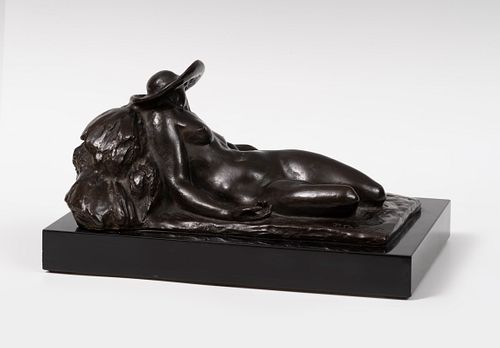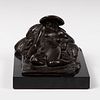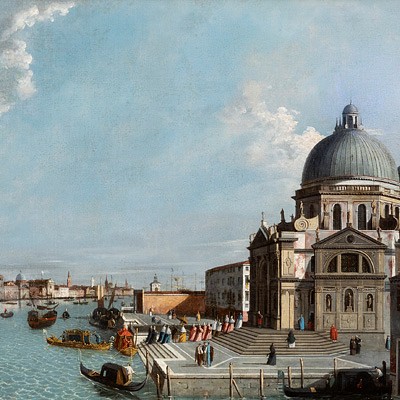PABLO GARGALLO CATALÁN (Maella, Zaragoza, 1881 - Reus, Tarragona, 1934). "Sleeper", 1924. Bronze, 1/3. Provenance: Malborough Gallery Madrid; Pierr
Lot 51
About Seller
Setdart Auction House
Carrer Aragó 346
Barcelona
Spain
Setdart Subastas was born in 2004 and is currently the first online art auction in Spain with solidity, prestige and reliability guaranteed by our more than 60,000 users. Setdart has a young, dynamic and enterprising team ready to successfully manage the purchase and sale of art works through custom...Read more
Categories
Estimate:
EUR€35,000 - EUR€40,000
$36,458.33 - $41,666.67
Absentee vs Live bid
Two ways to bid:
- Leave a max absentee bid and the platform will bid on your behalf up to your maximum bid during the live auction.
- Bid live during the auction and your bids will be submitted real-time to the auctioneer.
Bid Increments
| Price | Bid Increment |
|---|---|
| EUR€0 | EUR€10 |
| EUR€200 | EUR€25 |
| EUR€500 | EUR€50 |
| EUR€1,000 | EUR€100 |
| EUR€3,000 | EUR€200 |
| EUR€5,000 | EUR€500 |
| EUR€10,000 | EUR€1,000 |
| EUR€20,000 | EUR€2,000 |
| EUR€50,000 | EUR€5,000 |
About Auction
By Setdart Auction House
May 18, 2021
Set Reminder
2021-05-18 09:30:00
2021-05-18 09:30:00
America/New_York
Bidsquare
Bidsquare : Classics XIX and XX
https://www.bidsquare.com/auctions/setdart-auction-house/classics-xix-and-xx-6961
The next 18th May there will be a 19th and 20th Century Classics Auction at Setdart.com There will be a select repertoire of important artists such as Carlos Cruz Diez, Luis Feito, Joan Miró, Fernando Botero, Josep Llimona, Salvador Dalí among others. Setdart Auction House sofia@setdart.com
The next 18th May there will be a 19th and 20th Century Classics Auction at Setdart.com There will be a select repertoire of important artists such as Carlos Cruz Diez, Luis Feito, Joan Miró, Fernando Botero, Josep Llimona, Salvador Dalí among others. Setdart Auction House sofia@setdart.com
- Lot Description
PABLO GARGALLO CATALÁN (Maella, Zaragoza, 1881 - Reus, Tarragona, 1934). "Sleeper", 1924. Bronze, 1/3. Provenance: Malborough Gallery Madrid; Pierrette Gargallo. Attached certificate issued by Pierrette Gargallo Anguera, author's daughter. Signed and dated. Work reproduced in: - Reasoned Catalog of the artist, Pierrette Gargallo-Anguera, p. 133, # 108. - “Complete Catalog of Pablo Gargallo's work”, Pierrette Couration, p. 70. Measurements: 11.8 x 26 x 18 cm. "Sleeping" or "The Harvester" personifies, through an opulent female nude lying on sheaves of wheat, the spirit and image of the Catalonia Gargallo loved. Created by the Aragonese artist in 1924, the year in which he settled permanently in Paris and began one of the most interesting periods of his artistic career, there are other examples of this same sculpture housed in the Museo Nacional Centro de Arte Reina Sofía and the Museo Nacional de Arte de Cataluña. Pablo Gargallo is considered the precursor of iron sculpture, and learned the technique of forging with his father, who owned a blacksmith shop. In 1888 his family emigrated to Barcelona for economic reasons and there he began his artistic training, in the workshop of the sculptor Eusebio Arnau and in the School of La Lonja, with Venancio Vallmitjana as his main teacher. At the height of Modernism in Barcelona, Gargallo frequented the gatherings of "Els quatre Gats", establishing relationships with artists such as Nonell and Picasso. It is for this reason that his first works are influenced by Modernism, as is the case of the decoration of Barcelona buildings that he made in collaboration with the architect Domènech i Montaner, such as the Hospital de la Santa Cruz y San Pablo or the Palau de la Música. In 1903 Gargallo obtained a scholarship that allowed him to travel to Paris to complete his studies. His stay in the French capital was brief, but from then until 1923, when he settled permanently in Paris, his trips there would be frequent. In this city he found the aesthetic formulations of cubism, assimilated its expressive systems and sought the schematism and essentiality of figures and objects, trying to find the authentic three-dimensional expression of the cubist postulates. During these years he began to use metallic materials such as sheet metal, copper and iron. Around 1911-12 he made his first masks, pieces of great simplification made with cut sheet metal, linked to the cubist aesthetic. Using sheet metal, Gargallo began to suggest volumes and exalt the voids through the penetration of light into the interiors. In 1920 he was appointed professor of sculpture at the Escuela Técnica de Oficios Artísticos de la Mancomunidad de Cataluña, a post from which he was removed in 1923 for political reasons. It was then that Gargallo settled permanently in Paris with his wife and daughter. From this moment on his style acquires a very personal dimension, derived from his interpretation of cubism, based on the search for a formal synthesis of the figure in geometric planes always fluid, replacing conventional materials with wrought iron sheets, and introducing a new sculptural language by introducing the void as volume and giving his figures a great expressive dramatism. Throughout his life, Gargallo developed in parallel two apparently opposing styles: one with classical roots, related first to modernism and later to noucentisme, and the other avant-garde, which experiments with the disintegration of space. Pablo Gargallo is currently represented in the museum that bears his name in Zaragoza, the MoMA in New York, MACBA in Barcelona, the Museum of Modern Art in Paris and the Reina Sofia in Madrid, among many others.Attached certificate issued by Pierrette Gargallo Anguera, author's daughter.
Condition
- Shipping Info
-
In-House Shipping
-
- Buyer's Premium



 EUR
EUR CAD
CAD AUD
AUD GBP
GBP MXN
MXN HKD
HKD CNY
CNY MYR
MYR SEK
SEK SGD
SGD CHF
CHF THB
THB

















